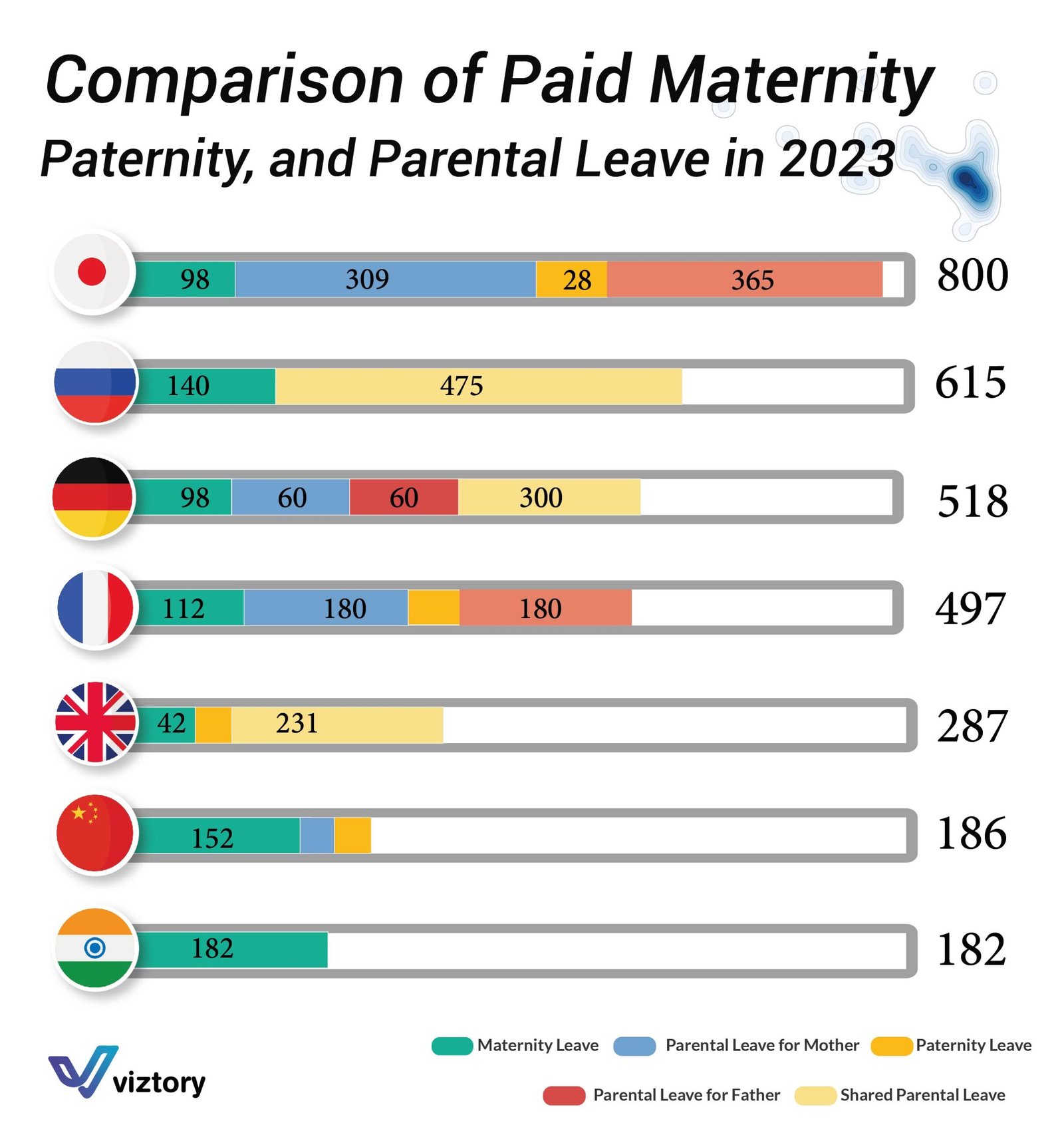Paid Leave Policies: A Global Healthcare Perspective
-
Aug, Thu, 2024
Paid Leave Policies: A Global Healthcare Perspective
In 2023, paid maternity, paternity, and parental leave policies have become a critical component of global healthcare strategies, reflecting the importance of supporting families during early child-rearing years. These policies are essential not only for the well-being of parents but also for the overall health and development of children. The comparative data presented in the image highlights the disparities in paid leave across different countries, providing insights into how nations prioritize healthcare and family support.
Global Overview of Paid Leave
The chart compares seven countries—Japan, Russia, Germany, France, the United Kingdom, China, and India—each with varying levels of paid leave for parents. These differences are not just statistical; they represent the cultural and political values placed on family care within each nation.
-
Japan: With 800 days of combined leave, Japan leads the chart, offering substantial support through 98 days of maternity leave, 309 days of parental leave for mothers, and 365 days of shared parental leave. The inclusion of shared leave underscores Japan’s progressive stance on equal parenting responsibilities.
-
Russia: Russia follows with 615 days, providing 140 days of maternity leave and 475 days of parental leave for mothers. The absence of significant paternity leave indicates a traditional approach, where the mother is primarily responsible for early childcare.
-
Germany: Germany offers a balanced 518 days, with 98 days of maternity leave and equal 60 days of paternity and parental leave for both parents, followed by 300 days of shared leave. This structure promotes a more equal distribution of childcare duties between parents.
-
France: France provides 497 days of leave, with 112 days of maternity leave, 180 days each for parental leave for both parents, and shared leave. This emphasizes the importance of parental involvement from both mother and father in child development.
-
United Kingdom: With 287 days, the UK’s policy is more limited but still includes 42 days of maternity leave and 231 days of shared leave. The shared leave reflects the country’s focus on flexibility and parental choice.
-
China: Offering 186 days, China provides 152 days of maternity leave and minimal parental leave, indicating a traditional family structure where mothers are the primary caregivers.
-
India: India has the most minimal provision, with 182 days of maternity leave and no formal parental or paternity leave. This highlights significant challenges in the support structure for working parents in the country.
The Healthcare Implications
Paid leave policies directly influence the health and well-being of families. Adequate maternity leave ensures that mothers have time to recover from childbirth and bond with their newborns, which is crucial for both maternal and infant health. Paternity and parental leave further enhance the family’s ability to provide care and create a supportive environment, reducing stress and improving mental health outcomes.
Countries with generous paid leave policies, such as Japan and Germany, demonstrate a commitment to integrating family health into broader healthcare strategies. These policies help reduce the burden on healthcare systems by promoting early preventive care, reducing postpartum depression, and improving child development outcomes.
Challenges and Considerations
Despite the clear benefits, disparities in leave policies reflect broader socio-economic and cultural differences. In countries like India and China, where leave policies are less generous, there may be significant barriers to achieving optimal family health outcomes. Economic constraints, societal norms, and the lack of robust healthcare infrastructure can limit the effectiveness of these policies.
Moreover, the availability of shared parental leave, as seen in Japan, Germany, and the UK, is a critical factor in promoting gender equality and enabling both parents to contribute to childcare. This not only supports family health but also encourages a more balanced distribution of labor within households.
Conclusion
The comparison of paid maternity, paternity, and parental leave across these seven countries reveals significant variations in how nations support families and integrate family care into their healthcare systems. As healthcare policies continue to evolve, the importance of comprehensive paid leave cannot be overstated. Ensuring that all parents have adequate time to care for their children is a crucial step toward improving global health outcomes and fostering a more equitable society.

